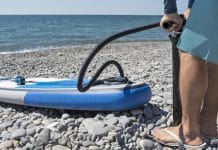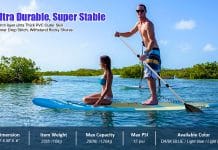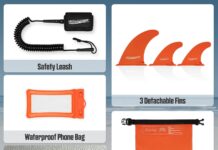Stand-up paddle Boarding, or SUP commonly known, has been steadily gaining popularity as a water sport and recreational activity. But is it just a fun way to pass the time on the water, or does it provide a good workout?
Well, if you’re looking for a unique way to engage your entire body while enjoying nature’s serenity, then SUP might just be the ultimate workout you’ve been searching for.
From strengthening your core and improving your balance, to giving your arms and legs a solid workout, stand up paddle boarding offers a multitude of physical benefits that will leave you feeling invigorated and accomplished.
So, grab your paddle, hop on your board, and let’s explore why SUP is more than just a leisurely water activity.
Review contents
Benefits of Stand-Up Paddle Boarding as a Workout
Stand Up Paddle Boarding (SUP) is a fun and relaxing way to enjoy nature and offers numerous benefits for our overall fitness and well-being. Let’s dive into some of the critical advantages of SUP as a workout.
Improved balance and core strength
When you start paddle boarding, one of the first things you will notice is the continual need to engage your core to maintain balance and stability. This constant engagement of your core muscles, including your abdominal muscles and lower back, helps to strengthen and tone these crucial muscles. As we become more skilled at balancing on the board, our overall sense of balance and stability improves, which can be beneficial not only during water-based activities but also in our daily lives.
Cardiovascular exercise
Stand Up Paddle Boarding is a fantastic way to get your heart pumping and lungs working. When we paddle, our bodies engage in a continuous pushing and pulling motion, which helps to elevate our heart rate and boost our cardiovascular fitness. This type of aerobic exercise can improve our endurance over time and contribute to a healthier heart and lungs.
Full-body workout
Paddleboarding provides a full-body workout, unlike many other types of exercise or sports that mainly target specific muscle groups. When we paddle, we not only engage our core muscles but also recruit our leg muscles, including the quadriceps, hamstrings, and calf muscles. Additionally, our arm and shoulder muscles are actively involved in propelling us forward through the water. This comprehensive engagement of multiple muscle groups leads to increased muscle strength and endurance throughout our body.
Low-impact exercise
For those looking for a low-impact workout option that is gentle on the joints, stand up paddle boarding is an excellent choice. Unlike activities such as running or high-impact aerobics, where the constant pounding can take a toll on our joints, the buoyancy of the water helps to reduce the impact on our body. This makes SUP a suitable workout for individuals of all fitness levels, including those who may have joint issues or are recovering from injuries.
Muscles Used in Stand-Up Paddle Boarding
Engaging in stand-up paddle boarding requires the activation of various muscle groups. Let’s look at the specific muscles prominently used during this workout.
Leg muscles
Your leg muscles, including your quadriceps, hamstrings, and calf muscles, provide stability and power during paddle boarding. While maintaining your balance on the board, these muscles act as stabilizers, allowing you to stand upright and propel yourself through the water. The repetitive bending and straightening of your legs as you paddle help to strengthen and tone these muscles over time.
Core muscles
As mentioned earlier, paddle boarding heavily relies on the engagement of our core muscles. These muscles, including the rectus abdominis, obliques, and erector spinae, work together to provide stability and balance on the board. By constantly engaging our core as we paddle, we effectively strengthen these muscles, improving posture and spinal alignment and reducing the risk of back pain.
Arm and shoulder muscles
Our arm and shoulder muscles are essential for propelling us forward through the water during paddle boarding. We use our biceps, triceps, and deltoids with each stroke to paddle and navigate our way. Over time, repetitive paddling can help develop and tone these muscles, increasing upper-body strength and endurance.
Calories Burned in Stand-Up Paddle Boarding
Stand Up Paddle Boarding provides an excellent opportunity to soak up the sun and enjoy nature and enables us to burn calories and maintain a healthy weight. The number of calories burned during a paddle-boarding session can vary depending on various factors.
Factors affecting calorie burn
Several factors can influence the number of calories burned during paddle boarding. These include our weight, the intensity of the paddling, the duration of the activity, and the environmental conditions. Generally, the more effort we put into paddling, the more calories we can expect to burn.
Average calorie burn in stand-up paddle boarding
On average, a 150-pound person can burn around 400-700 calories per hour of stand up paddle boarding, depending on the intensity of their paddling. This calorie burn is comparable to other moderately intense activities such as brisk walking or cycling. However, it’s essential to remember that individual calorie burn may vary based on weight, fitness level, and effort put into the activity.
Improving Fitness through Stand-Up Paddle Boarding
While stand-up paddle boarding offers various health benefits on its own, there are several strategies we can employ to maximize our fitness gains and take our workouts to the next level.
Increasing intensity and duration
To continuously challenge our bodies and enhance our fitness, we can gradually increase the intensity and duration of our paddle boarding sessions. Increasing the speed and effort put into paddling can elevate our heart rate further and push our cardiovascular fitness. Similarly, gradually extending the duration of our sessions allows us to burn more calories and build endurance.
Incorporating interval training
Interval training involves alternating periods of high-intensity exercise with periods of lower intensity or rest. By incorporating interval training into our paddle boarding routine, we can effectively boost our cardiovascular fitness, burn more calories, and enhance our overall athletic performance. For example, paddling at a high intensity for a specific distance or time, followed by a period of slower paddling or rest, can be an excellent way to incorporate intervals into our workout.
Adding strength and balance exercises
We can incorporate strength and balance exercises into our routine to complement our paddle-boarding workouts and enhance our fitness.
These exercises can include squats, lunges, planks, and yoga poses that target the muscles used in paddle boarding. By strengthening these muscle groups and improving our balance, we can become more efficient paddle boarders and reduce the risk of injuries.
Preventing Injuries in Stand-Up Paddle Boarding
While stand-up paddle boarding is generally considered a safe activity, taking precautions to prevent injuries and ensure a safe and enjoyable experience on the water is essential.
Proper warm-up and stretching
Before hitting the water, it’s crucial to warm up our muscles and prepare our body for the physical demands of paddle boarding. A warm-up routine that includes dynamic stretches and light aerobic exercises, such as jogging or jumping jacks, can help increase blood flow and reduce the risk of strains or muscle imbalances.
Gradual progression and technique improvement
When starting paddle boarding or trying new techniques, we must progress gradually and listen to our body’s limits. Trying to perform advanced maneuvers or pushing ourselves too hard without adequate skill and experience can lead to accidents and injuries. Taking lessons from a certified instructor can be beneficial in learning the proper techniques and form, reducing the risk of strain or overuse injuries.
Using protective gear
We must wear appropriate protective gear to ensure our safety while paddle boarding. A well-fitted personal flotation device (PFD) is a must, especially for those who are not strong swimmers. Additionally, wearing a leash that attaches the board to our ankle can prevent the board from drifting away from us in case we fall into the water. This can help avoid collisions with other watercraft or hazards.
Safety Considerations for Stand-Up Paddle Boarding as a Workout
While paddle boarding can be an enjoyable and effective workout, it’s essential to be aware of specific safety considerations to ensure our well-being and the safety of others around us.
Navigating water conditions
Before heading out for a paddle boarding workout, it’s vital to assess the water conditions. Wind, waves, tides, and currents can significantly impact our paddle-boarding experience and safety. It’s recommended to check weather forecasts, tide charts, and familiarize ourselves with the local water conditions to avoid unexpected hazards or challenging situations.
Monitoring weather conditions
In addition to the water conditions, it’s essential to keep an eye on the weather forecast. Weather changes such as sudden storms, high winds, or lightning can create unsafe conditions for paddle boarding. It’s essential to exercise caution and avoid going out on the water during severe weather or when thunderstorms are imminent.
Knowing and following local regulations
Different areas may have specific regulations or restrictions regarding paddle boarding. Awareness of any local rules, permits, or designated areas for paddle boarding is crucial. Following these regulations not only ensures our safety but also helps to protect the environment and maintain harmony with other water users.
Stand-Up Paddle Boarding vs. Other Water Sports as a Workout
When considering water sports as a workout option, it’s natural to compare the benefits and engage in activities that align with our fitness goals. Let’s explore how stand up paddle boarding compares to other popular water sports in terms of calorie burn and muscle engagement.
Comparing calorie burn and muscle engagement with other water sports
Stand up paddle boarding provides a moderate-intensity workout that can help burn calories and improve our overall fitness. The calorie burn and muscle engagement in paddle boarding can vary compared to other water sports such as kayaking, surfing, or swimming. However, paddle boarding stands out as a full-body workout that engages multiple muscle groups, including the core, legs, and upper body.
Considerations for different fitness levels
While paddle boarding offers many benefits, it’s essential to consider our current fitness level and individual preferences when choosing a water sport as a workout. Stand-up paddle boarding can be an ideal choice for a low-impact activity that focuses on balance, core strength, and relaxation. On the other hand, individuals seeking more intense cardio workouts or specific muscle targeting may find other water sports more suitable for their fitness goals.
Tips for Getting Started with Stand-Up Paddle Boarding as a Workout
If stand-up paddle boarding as a workout sounds appealing, here are some tips to get started and maximize your paddle boarding experience.
Choosing the right equipment
When getting started with paddle boarding, choosing the right equipment that suits your needs and skill level is essential. Selecting a stable and wide board can make it easier to maintain balance, especially for beginners. Additionally, choosing a paddle that is an appropriate length for your height and adjustable can help optimize your paddling technique.
Seeking instruction and guidance
It can be beneficial to seek instruction and guidance from a certified instructor to ensure your safety and make the most out of your paddle boarding workouts. They can teach you proper paddling techniques and safety considerations and help you build the necessary skills and confidence on the water. Taking a lesson or joining a group class can also be an excellent opportunity to meet fellow paddle boarders and form a supportive community.
Practicing proper technique
Proper technique is critical to maximizing the benefits of paddle boarding and preventing injuries. Learning the correct paddle stroke, stance, and turning techniques can significantly enhance your efficiency and enjoyment on the water.
Relying on your core muscles for stability and balance, rather than just your arms, can help prevent muscle fatigue and ensure a more effective paddle-boarding workout.
Conclusion
Stand Up Paddle Boarding is not only a fantastic way to connect with nature and enjoy the water, but it also offers various benefits for our fitness and well-being. From improved balance and core strength to cardiovascular exercise and a full-body workout, SUP provides a versatile and low-impact option for individuals of all fitness levels.
Incorporating paddle boarding into our fitness routines can burn calories, strengthen our muscles, and enhance our overall wellness. However, it’s crucial to prioritize safety, progress gradually, and seek proper instruction to ensure a safe and enjoyable paddle-boarding experience. So grab your paddle, hop on a board, and discover the joys and health benefits of stand up paddle boarding as a workout.

































